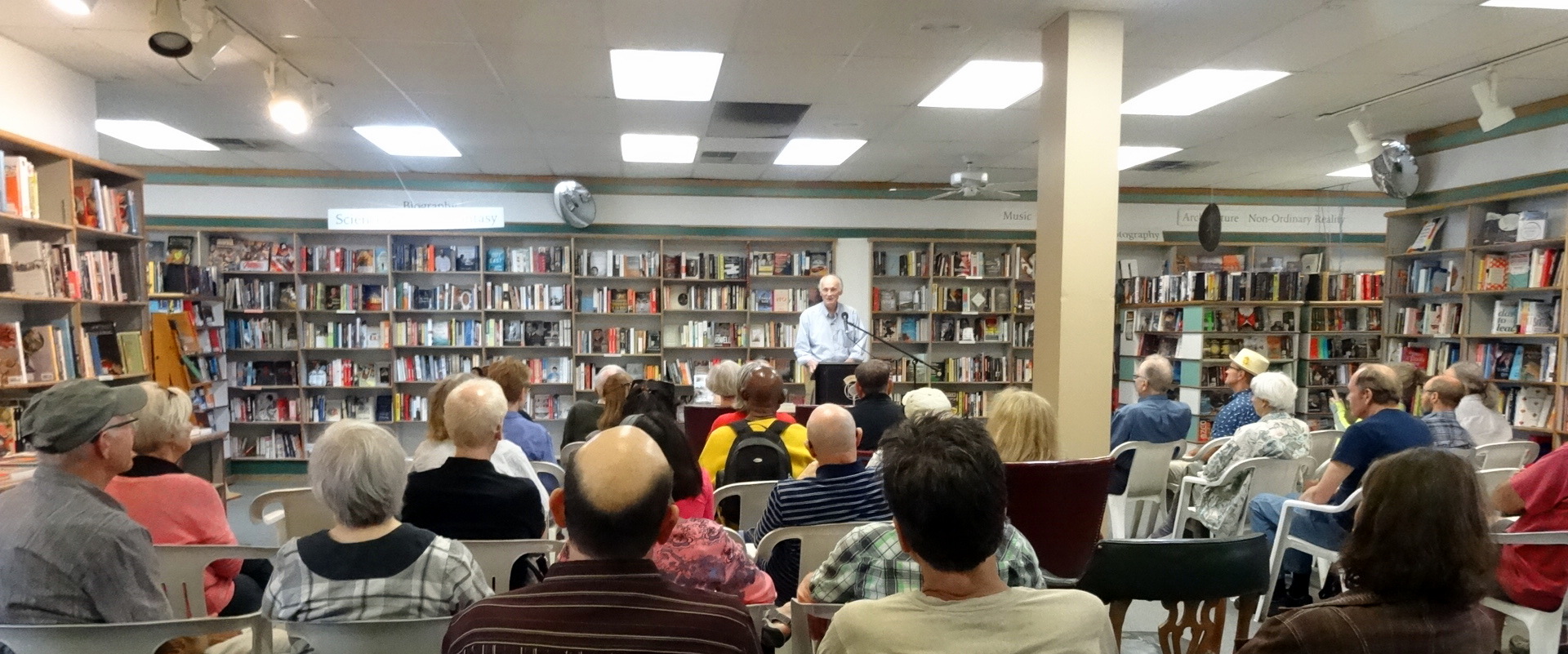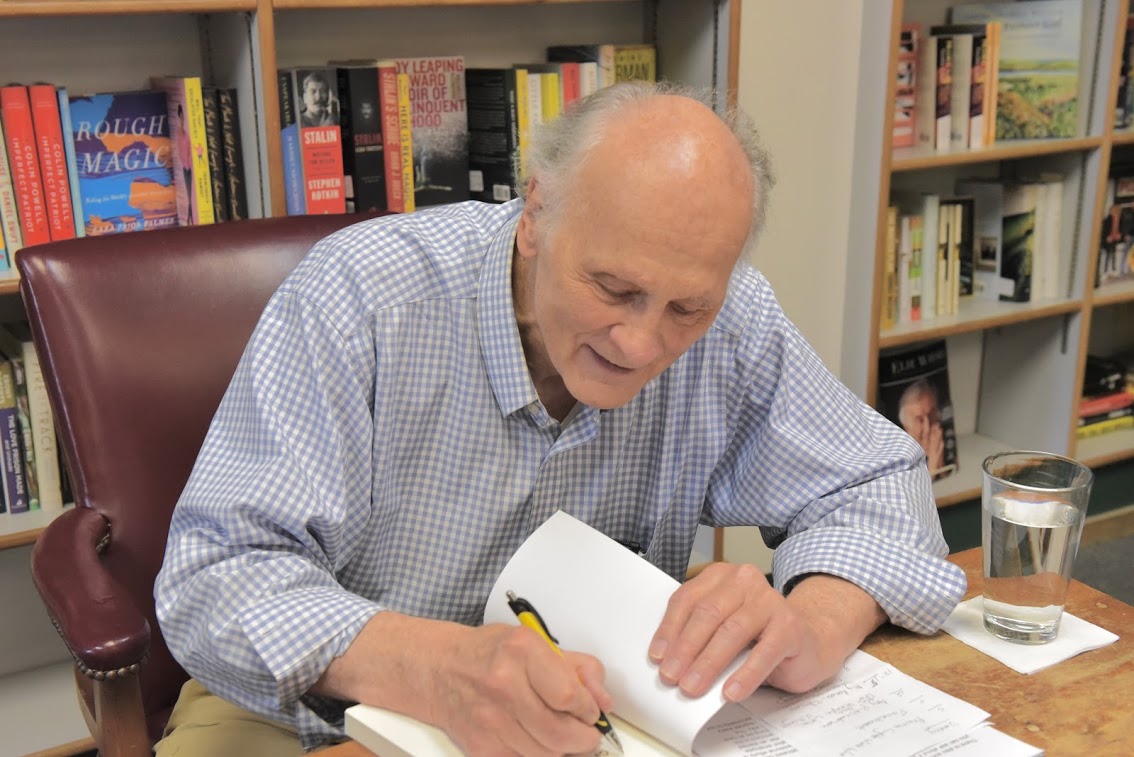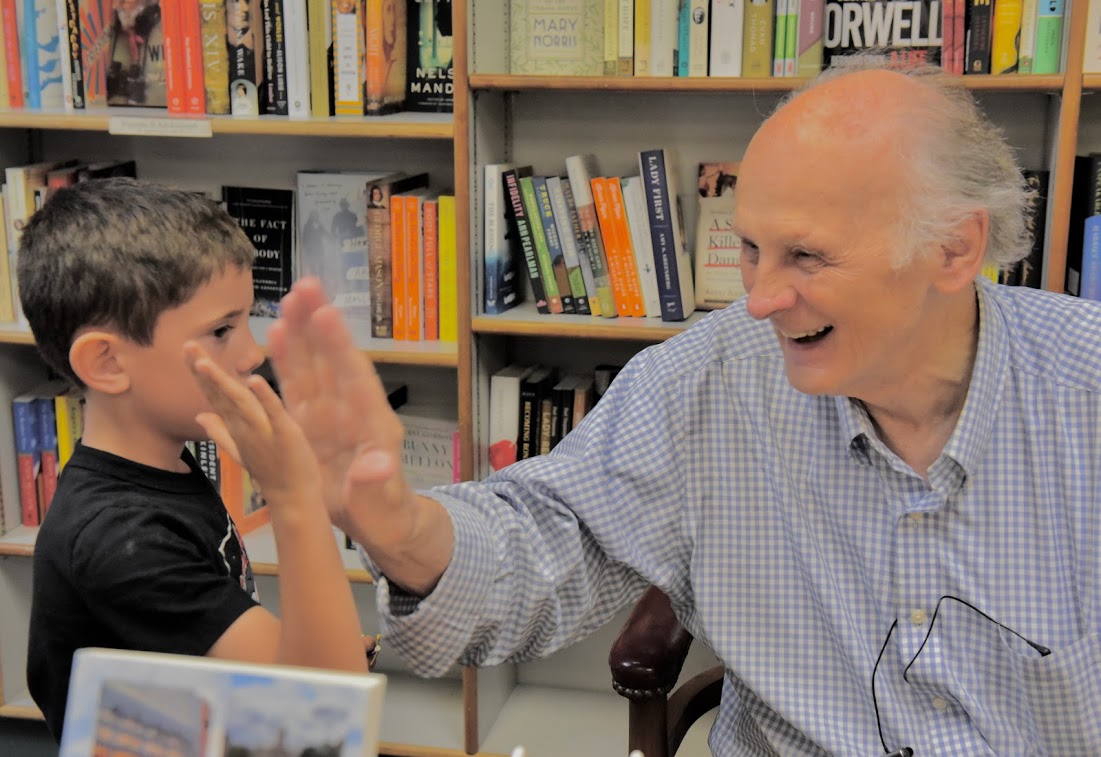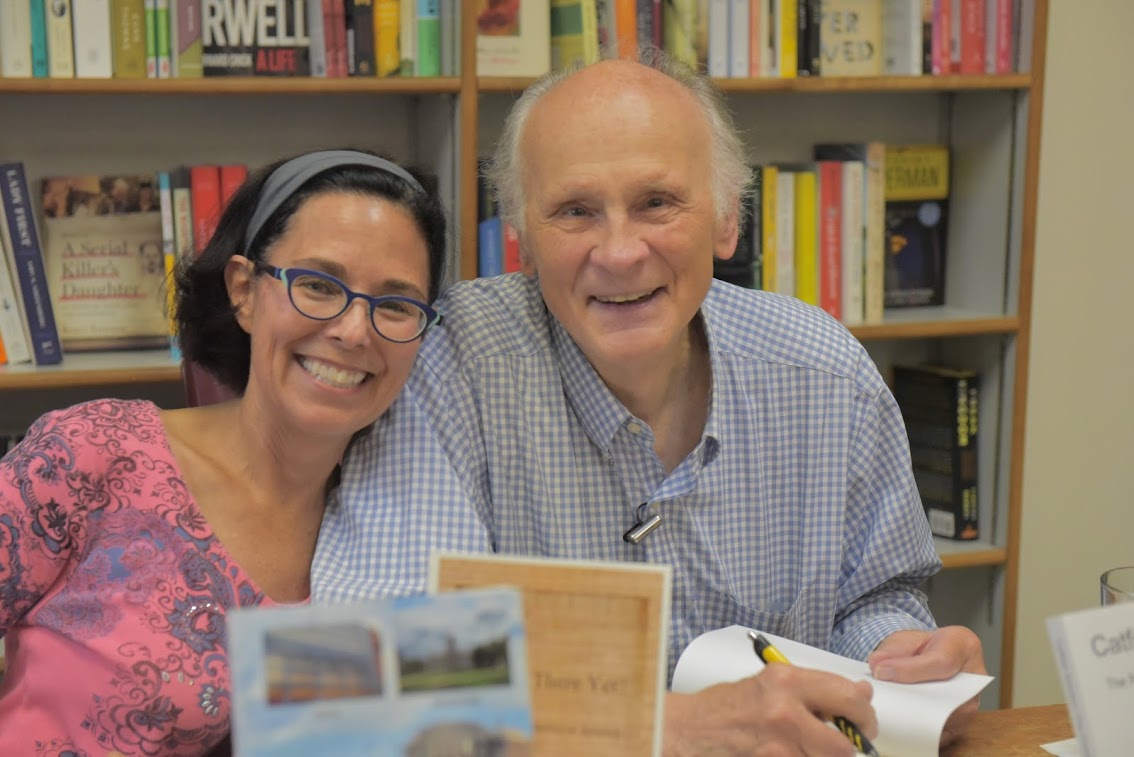
[Return to NicholasJohnson.org]
See below for:
Readings and Events (with photos, video and audio files); Back Cover of Book; Prairie Lights Bookstore’s Description of Catfish Solution; Passages from the Book; and Johnson’s Facebook Post About Prairie Lights Bookstore.
About
Nicholas Johnson’s latest book, Catfish Solution: The Power of Positive Poking (2019), is available from Iowa City’s Prairie Lights Bookstore, or if you live elsewhere, Amazon, Barnes & Noble, or the publisher, Lulu.
Readings & Events
 Johnson did a reading of Catfish Solution at Prairie Lights, August 24, 2019, 4:00-5:00 p.m. [Photo: Johnson greeting a few of the early arrivals; Photo credit: Mary Vasey.]
Johnson did a reading of Catfish Solution at Prairie Lights, August 24, 2019, 4:00-5:00 p.m. [Photo: Johnson greeting a few of the early arrivals; Photo credit: Mary Vasey.]

There is no record of what Johnson was trying to say at this moment in the reading (or what he may have just dropped). [Photo credit: Julie Johnson.]
The video below, Reading I, contains the entire event — reading and talk plus Q&A (except for Kathleen Johnson’s introduction, which is available at the beginning of the audio file, Reading III, below). [Smart phone camera credits to Becky and Sara Machtel and Julie Johnson, with extraordinary creative video editing and production by Gregory Johnson, Resources for Life.]
Here are three examples of Andrea Chapman Day’s photography, Andiday-Photography:

[Photo credit: Andrea Chapman Day, Andiday-Photography]

Chris Harris’ son Henry approved of the reading. [Photo credit: Andrea Chapman Day, Andiday-Photography]

Looks like Katia Maxey also liked the reading. [Photo credit: Andrea Chapman Day, Andiday-Photography]
The 5:08-minute video, Reading II, below, is a composite of three video clips taken on smart phones by audience members Julie Johnson and Sara Machtel. The first involves the author’s experience with teenage friends building an Allied Radio 10-in-one kit transmitter (phono oscillator) that could be heard on WSUI’s frequency (narrowly avoiding an encounter with the FCC) and a telegraph that caused a leak in Irving Weber’s house; the second is a story from his first day clerking for U.S. Supreme Court Justice Hugo Black; and the final clip involves his first surprise meeting with President Lyndon B. Johnson (no relation) when the author was offered, and resisted, an appointment as U.S. Maritime Administrator. (Some text for the first and third clips can be found on this page, below, under the heading “Passages from the Book.”)
An audio-only version of the event, Reading III — introduction by Prairie Lights’ moderator, Kathleen Johnson (no relation), Johnson’s reading, and audience Q&A — is available below. [Audio editing credit: Gregory Johnson, Resources for Life.]
Back Cover of Book
Catfish Solution: The Power of Positive Poking is a story, revelation and explanation; some comedy, mystery, and inspiration to action.
The story is how a young boy who couldn’t manage a canoe on the Iowa River took on America’s shipping and broadcasting industries. The revelation and explanation are what he learned about how Washington works. The comedy is provided by FCC decisions so bizarre as to be funny. The mystery is: “Why the catfish?” – only revealed by reading the book. The inspiration to action comes from asking, “How could a catfish strategy benefit you and your country?”
Here are some comments about the author during the years he was getting into all this trouble:
- “Nick Johnson is currently the citizen’s least frightened friend in Washington and this book tells why.” – John Kenneth Galbraith, Harvard Economist
- “Johnson … has singlehandedly undertaken to reform U.S. television … [and] has written a most engaging polemic.” – William F. Buckley, National Review and Firing Line
- “In Washington in general, it is difficult not to regard Johnson as a superstar, one of our few friends.” – Rolling Stone
- “We won’t see another Nicholas Johnson for a long, long time. Corporate America simply will not again make the mistake of allowing men like him in sensitive positions.” – Chicago Daily News
- “In a business known for its phony glad hand, [Johnson is] the one person who gets a sincere cold shoulder from the industry. – Marvin Kitman, New York Times
- “It’s a shame this book wasn’t around in the ‘60s, so my brother Dick could have read it to me.” – Tom Smothers, Smothers Brothers Comedy Hour
Prairie Lights Bookstore’s Description of Catfish Solution
NICHOLAS JOHNSON
August 24, 2019 – 4:00pm
Prairie Lights
Iowa author and retired UI law professor Nicholas Johnson will read from his recent book. Catfish Solution: The Power of Positive Poking. Catfish Solution is memoir and story, revelation and explanation, comedy and critique with inspiration to citizen action by a Washington insider who took on the shipping and broadcasting industries.
Johnson is the author of Columns of Democracy. He has been a TV show host, columnist, congressional candidate, Washington lawyer, and school board member, among other things. Included in The Yale Biographical Dictionary of American Law as one of 700 individuals described by the publisher as “leading figures in the history of American law, from the colonial era to the present day,” he has retired from teaching at the University of Iowa College of Law.
Passages from the Book
How the author, who went on to become Federal Communications Commission Commissioner Nicholas Johnson, narrowly escaped prosecution by the FCC when a young boy
A University of Iowa criminology professor, Richard Holcomb, administered an annual Iowa Peace Officers Short Course for state and local law enforcement officers which he invited us [the author’s group of about a half-dozen junior high boys] to attend. That was where we learned of the importance of communications to police work, and Mr. Holcomb provided us some catalogs from radio equipment suppliers.
Since none of us had either a police car or the money to acquire radio equipment we bought a ten-in-one kit from Allied Radio in Chicago for thirteen dollars. The catalog informed us that with this kit we would be able to build from among the ten choices a phono oscillator. This device was intended to enable the utilization of an AM radio receiver to play music, from a phonograph without an amplifier, through the radio’s amplifier and speaker.
To broadcast from the phonograph to the radio an antenna was attached to the phono oscillator. The instructions warned that one should never use more than a 25-foot antenna. This was exactly the wrong thing to advise junior high school boys. We promptly climbed out the attic window onto the roof of my parents’ home and began stringing up 500 feet of braided copper wire.
Although the voice transmission would only broadcast on unused frequencies we discovered when we broadcast in Morse code the signal could be received on a car radio parked directly under the antenna of the 5,000-kilowatt local radio station, WSUI [then on Mormon Trek Blvd]. Scarcely had our experiment concluded when one of our members, Howard Berg, reported from Iowa City’s east side that he had seen an FCC monitoring truck. We never knew the truth of that report, but I always suspected that the time it took us to turn that transmitter back into a ten-in-one kit radio receiver would have set a record.
During the Second World War Iowa City was the location for a U.S. Navy pre-flight training school. . . . I also attended a Navy course in Morse Code and, after our near run-in with the FCC, constructed a telegraph service between my house and that of neighbor [Irving, Martha and] Willie Weber. The use of wire required pounding nails through the roof of Willie’s house, the leaks from which his mother, Martha, would remind us for years. It also involved draping copper wire through the trees of a neighbor’s yard which significantly weakened the signal. My mother suggested if we really wanted to talk to each other we might just use the telephone, but mothers never understand such things. (pp. 18-20)
The author’s first visit to the Oval Office.
There was a phone message on my desk at Covington & Burling one day informing me of a forthcoming meeting with Bill Moyers. Never having been in the West Wing before, I arrived a little early, was ushered through the gate by the guards, and told to wait in a West Wing reception area outside the press offices. It was exciting just to be there watching aides to the President and journalists, some of whom were recognizable from television, going about their tasks.
The story went around, and appeared in some newspapers, that Bill Moyers and I had been roommates in Austin, and that it was he who urged my appointment on the President. The fact is that Bill and I were both married and living with our wives while at the University of Texas and that we never met until after my appointment.
As time wore on it became somewhat less exciting – fifteen minutes, a half hour, finally an hour slipped by. It was an introduction to the pressures of officials’ schedules, their relative insensitivity to callers, that mark much of official Washington – and into which I would soon find myself sliding.
Suddenly, through the door bounded the bundle of smiles and energy known as Jack Valenti. He quickly introduced himself, asked that I follow him, and we went dashing through corridors of the White House. He opened a door, motioned to me to enter, turned and left.
When I looked up I realized I was in the Oval Office of the President, alone with President Johnson. As if a forecast of things to come, he was watching a television screen in the three-TV console given him by Frank Stanton of CBS . . ..
The surrealism of the experience left very little memory of our conversation. We probably talked for fifteen or twenty minutes. He said he wanted to nominate me as Maritime Administrator, and told me something of the industry, the agency, his plans for it, and how I should go about getting through my Senate hearings.
It was not clear why the President wanted to appoint me to this position. Was it possible some scandal was about to break for which I’d be the fall guy? . . .
President Johnson was prescient enough to know, confronted with a short list of 15 or 20 individuals who wanted to be Maritime Administrator, and knowing of the ties between the industry and the agency, that the most important qualification was an individual who did not want the job. That may have been my only qualification. (pp. 53, 54,55, 57)
Johnson’s Facebook Post About Prairie Lights Bookstore, Aug. 28, 2019
This is a shout out to Prairie Lights Bookstore, where I did my second reading of the year last Saturday, Aug. 24 (Catfish Solution). My thanks to Jan Weismiller, her helpful staff, and especially to Kathleen Johnson who set up the reading, introduced me, moderated the discussion and made it a happy afternoon for all.
Thanks also to all of you who turned out on a sunny afternoon to fill the hall. For all who wanted to come but couldn’t, a full audio track, some photos, selections from the book and a video (later more) is available [see above].
In the first reading of the year (Columns of Democracy), I talked about the foundation of essential institutions necessary to build and retain a democracy (e.g., independent media and judiciary). One cluster of those institutions includes First Amendment-protected books, bookstores and libraries; especially independent local bookstores. Thus, Prairie Lights, one of the reasons Iowa City was selected in 2008 as the UNESCO’s only global “City of Literature” in the United States, is not only a comfortable famous place to browse (and hopefully buy) books (and grab a coffee and something to eat), it is one of the institutions supporting Iowa City’s democracy.
And by providing local authors a place to display and talk about their books, it is strengthening Iowa City’s sense of community as well. If you haven’t been there recently, pay them a visit.
# # #
[Return to NicholasJohnson.org]
